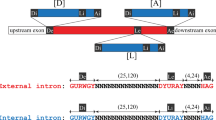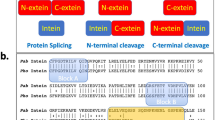Abstract
SOME group II introns are mobile elements as well as catalytic RNAs1,2. Introns aI1 and aI2 found in the gene COX1 in yeast mitochondria encode reverse transcriptases which promote site-specific insertion of the intron into intronless alleles ('homing')3–6. For aI2 this predominantly occurs by reverse transcription of unspliced precursor RNA at a break in double-strand DNA made by an endonuclease encoded by the intron7. The aI2 endonuclease involves both the excised intron RNA, which cleaves the DNA's sense strand by partial reverse splicing; and the intron-encoded reverse transcriptase which cleaves the antisense strand8. Here we show that aI1 encodes an analogous endonuclease specific for a different target site compatible with the different exon-binding sequences of the intron RNA. Over half of aI1 undergoes complete reverse splicing in vitro, thus integrating linear intron RNA directly into the DNA. This unprecedented reaction has implications for both intron mobility and evolution, and potential genetic engineering applications.
This is a preview of subscription content, access via your institution
Access options
Subscribe to this journal
Receive 51 print issues and online access
$199.00 per year
only $3.90 per issue
Buy this article
- Purchase on Springer Link
- Instant access to full article PDF
Prices may be subject to local taxes which are calculated during checkout
Similar content being viewed by others
References
Lambowitz, A. M. & Belfort, M. A. Rev. Biochem. 62, 587–622 (1993).
Michel, F. & Ferat, J.-L. A. Rev. Biochem. 64, 435–461 (1995).
Meunier, B., Tian, G.-L., Macadre, C., Slonimski, P. P. & Lazowska, J. in Structure, Function and Biogenesis of Energy Transfer Systems (eds Quagliariello, E., Papa, S., Palmieri, F. & Saccone, C.) 169–174 (Elsevier Scientific, Amsterdam, 1990).
Kennell, J. C., Moran, J. V., Perlman, P. S., Butow, R. A. & Lambowitz, A. M. Cell 73, 133–146 (1993).
Lazowska, J., Meunier, B. & Macadre, C. EMBO J. 13, 4963–4972 (1994).
Moran, J. V. et al. Molec. cell. Biol. 15, 2828–2838 (1995).
Zimmerly, S., Guo, H., Perlman, P. S. & Lambowitz, A. M. Cell 82, 545–554 (1995).
Zimmerly, S. et al. Cell 83, 529–538 (1995).
Moran, J. V. et al. Nucleic Acids Res. 22, 2057–2064 (1994).
Herschlag, D. & Cech, T, R. Nature 344, 405–409 (1990).
Robertson, D. L. & Joyce, G. F. Nature 344, 467–468 (1990).
Mörl, M., Niemer, I. & Schmelzer, C. Cell 70, 803–810 (1992).
Mörl, M. & Schmelzer, C. Cell 60, 629–636 (1990).
Mörl, M. & Schmelzer, C. Nucleic Acids Res. 18, 6545–6551 (1990).
Mueller, M. W., Allmaier, M., Eskes, R. & Schweyen, R. J. Nature 366, 174–176 (1993).
Sambrook, J., Fritsch, E. F. & Maniatis, T. Molecular Cloning: A Laboratory Manual 2nd edn (Cold Spring Harbor Laboratory, New York, 1989).
Hebbar, S. K., Belcher, S. M. & Perlman, P. S. Nucleic Acids Res. 20, 1747–1754 (1992).
Author information
Authors and Affiliations
Rights and permissions
About this article
Cite this article
Yang, J., Zimmerly, S., Perlman, P. et al. Efficient integration of an intron RNA into double-stranded DNA by reverse splicing. Nature 381, 332–335 (1996). https://doi.org/10.1038/381332a0
Received:
Accepted:
Issue Date:
DOI: https://doi.org/10.1038/381332a0
This article is cited by
-
Metal ions and sugar puckering balance single-molecule kinetic heterogeneity in RNA and DNA tertiary contacts
Nature Communications (2020)
-
DNA–RNA hybrids: the risks of DNA breakage during transcription
Nature Structural & Molecular Biology (2017)
-
Biotechnological applications of mobile group II introns and their reverse transcriptases: gene targeting, RNA-seq, and non-coding RNA analysis
Mobile DNA (2014)
-
Crystal structure of a eukaryotic group II intron lariat
Nature (2014)
-
Learning to live together: mutualism between self-splicing introns and their hosts
BMC Biology (2011)
Comments
By submitting a comment you agree to abide by our Terms and Community Guidelines. If you find something abusive or that does not comply with our terms or guidelines please flag it as inappropriate.



